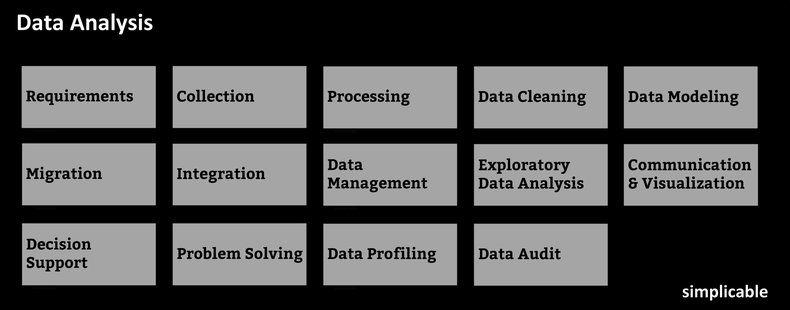

Requirements
Developing requirements for data that doesn't exist yet or modifications to existing data assets.Collection
Collecting data from a variety of sources into a new structure. For example, an ecommerce site that develops a product database using the product data from partners.Processing
Analysis of data processing steps such as business rules. For example, analysis of an algorithm that generates a risk score for credit applications.Data Cleaning
Improving the quality of data by removing errors and resolving inconsistencies.Data Modeling
Designing the structure of data and data relationships. Data modeling is a process of design that often requires significant analysis.Migration
The process of exporting data from a source, converting its format and structure and loading it into a target data repository. For example, migrating your customer database from a legacy system to a new system.Integration
Sharing data between data producers and data consumers, often in real time. For example, if a customer changes their address that address may be updated in multiple systems. Building integration transactions often requires significant analysis such as developing specifications for mappings between data models.Data Management
Analysis of the control and management of data. For example, an organization that is replicating customer data in multiple systems may conduct an analysis to consider a master data management strategy.Exploratory Data Analysis
Using data to confirm or develop strategies, plans and optimizations. For example, a marketing team uses historical sales data to confirm that a new pricing strategy is likely to improve revenue.Communication & Visualization
Finding meaningful patterns in data and documenting or visualizing such data in a way that is meaningful to people. For example, an operational team uses an analytics tool to visualize production metrics for a weekly report.Decision Support
Developing data to support decision making at the strategy or operational level. For example, a data analyst develops a report that benchmarks a firm's production costs against its main competition.Problem Solving
Analysis of data to support problem solving. For example, a firm that experiences a sudden drop in sales may conduct a data analysis to understand why.Data Profiling
Data profiling is the process of developing metadata such as data lineage information.Data Audit
Investigating and reporting the quality of data.| Overview: Data Analysis | ||
Type | ||
Definition | The systematic examination of data | |
Related Concepts | ||

































